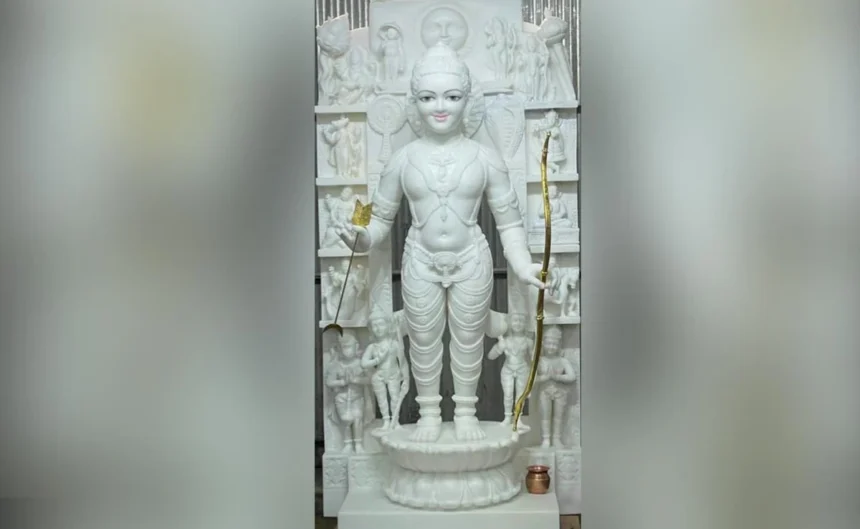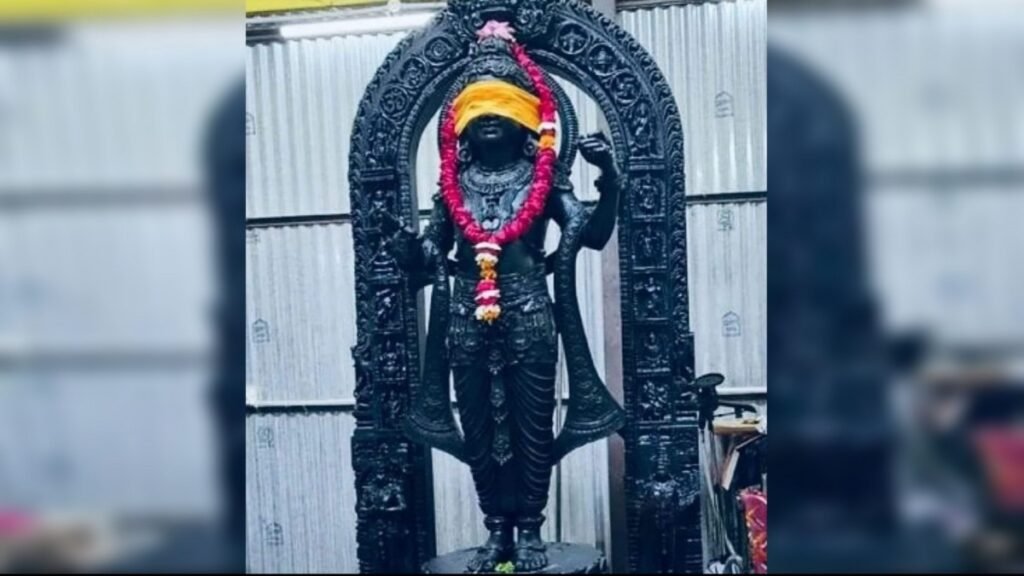Introduction:
In the heart of Ayodhya, where history and spirituality converge, the grand Ram Temple stands tall as a symbol of devotion and artistry. The recent ‘pran pratistha’ ceremony witnessed the installation of the black stone idol of Ram Lalla, crafted by the skilled hands of Mysuru sculptor Arun Yogiraj. Amidst the grandeur, another exquisite creation captured attention – Ram Lalla Idol Lost White Marble Version carved by Rajasthan’s Satyanarayan Pandey. Let’s delve into the details of this remarkable piece of craftsmanship that, although not gracing the temple’s sanctum sanctorum, will find its place of honor within the sacred precincts.
A Glimpse of Elegance:
The white marble idol, meticulously carved by Satyanarayan Pandey, currently rests in the custody of the temple trust. This intricately designed masterpiece portrays Ram Lalla holding a golden bow and arrow, embodying the divine essence of Lord Ram. The craftsmanship extends beyond the main deity. As an arch-like structure behind Ram Lalla showcases smaller sculptures depicting various incarnations of Lord Vishnu. The attention to detail is striking. With jewelry and clothes delicately chiseled out of marble. Adding a touch of regality to the idol.
The Dimensions of Devotion:
Satyanarayan Pandey’s creation adheres to the dimensions set by the trust overseeing the temple’s construction, aligning seamlessly with the architectural vision. While the 51-inch black granite idol, now residing in the sanctum sanctorum, has its roots in a 2.5-billion-year-old rock from Karnataka, Pandey’s white marble rendition brings a different aesthetic to the divine ensemble. The contrast between the two materials not only showcases diversity in craftsmanship but also pays homage to the rich tapestry of India’s artistic heritage.
Journey of the Stones:
The black stone idol crafted by Arun Yogiraj, now the focal point of the temple’s sanctum sanctorum, originates from a rock with an impressive age of 2.5 billion years. The durability and resistance to climatic variations in the subtropical zone make it a fitting choice, ensuring the idol’s endurance for thousands of years with minimal maintenance. The journey of this ancient rock from Karnataka to Ayodhya reflects the meticulous selection process undertaken by the temple trust, highlighting their commitment to preserving the sanctity of the sacred space.
The white marble used for Satyanarayan Pandey’s creation, on the other hand, adds a different dimension to the narrative. Hailing from Rajasthan, Pandey’s craftsmanship exemplifies the artistic diversity within the country. The marble, known for its elegance and purity, becomes a canvas for the sculptor’s vision, bringing forth a depiction of Lord Ram that is both timeless and enchanting.
Artists Behind the Magic:
Arun Yogiraj. The sculptor behind the black stone idol, expressed profound gratitude during the ‘pran pratistha’ ceremony. Considering it the best day of his life. Yogiraj. A Mysuru-based artist. Conveyed his belief that Lord Ram guided him through the creation process. Acknowledging the divine intervention in his artistic journey. Sleepless nights and meticulous precision resulted in a masterpiece that now graces the temple’s inner sanctum. Becoming a testament to Yogiraj’s dedication and faith.
Satyanarayan Pandey, the sculptor of the white marble idol, contributes his own chapter to the temple’s unfolding saga. His creation, though destined for a different part of the temple, resonates with the same level of devotion and artistic brilliance. The selection of Pandey’s work emphasizes the inclusive vision of the temple trust, recognizing the diverse talents that converge to shape this spiritual haven.
Ganesh Bhatt from Karnataka. Another artist whose sculpture was considered for the sanctum sanctorum. Joins Yogiraj and Pandey in contributing to the temple’s artistic wealth. Each artist brings a unique perspective. A distinctive touch that adds layers to the spiritual experience awaiting visitors once the temple is fully constructed.
A Temple in Progress:
While the black stone idol and the lost white marble version find their respective places within the temple. Much of the grand structure remains under construction. The first floor. Intended to house the idol of Raja Ram alongside Sita. Laxman. And Hanuman. Is yet to be completed. The ongoing construction mirrors the continuous evolution of this sacred space. Where artistry and devotion converge to create an enduring legacy.
Also read : A New Dawn in Ayodhya: Ram Temple Opens to Public After ‘Pran Pratishtha’ Ceremony
Conclusion:
In the unfolding narrative of the Ram Temple at Ayodhya. The presence of the black stone idol by Arun Yogiraj and the Ram Lalla Idol Lost White Marble Version by Satyanarayan Pandey adds layers of significance. Each sculpture. Born from the hands of dedicated artists, contributes to the rich tapestry of India’s cultural and spiritual heritage. As the construction progresses. The temple stands as a testament to the unity in diversity. Bringing together talents from different corners of the country to create a space that transcends time and resonates with the divine.







